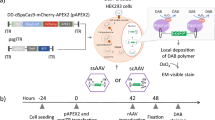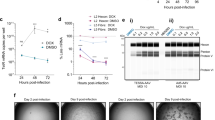Abstract
Adeno-associated virus (AAV) vectors package single-stranded genomes and require host-cell synthesis of the complementary strand for transduction. However, when the genome is half wild-type size, AAV can package either two copies, or dimeric inverted repeat DNA molecules. Dimeric, or self-complementary molecules (scAAV) should spontaneously reanneal, alleviating the requirement for host-cell DNA synthesis. We generated and characterized scAAV vectors in order to bypass the rate-limiting step of second-strand synthesis. In vitro, scAAV vectors were five- to 140-fold more efficient transducing agents than conventional rAAV, with a 5.9:1 particle to transducing unit ratio. This efficiency is neither greatly increased by co-infection with Ad, nor inhibited by hydroxyurea, demonstrating that transduction is independent of DNA synthesis. In vivo, scAAV expressing erythropoietin resulted in rapid and higher levels of hematocrit than a conventional single-stranded vector. These novel scAAV vectors represent a biochemical intermediate in rAAV transduction and should provide new insights into the biology of vector transduction.
This is a preview of subscription content, access via your institution
Access options
Subscribe to this journal
Receive 12 print issues and online access
$259.00 per year
only $21.58 per issue
Buy this article
- Purchase on Springer Link
- Instant access to full article PDF
Prices may be subject to local taxes which are calculated during checkout





Similar content being viewed by others
References
Cukor G, Blacklow NR, Hoggan D, Berns KI . Biology of adeno-associated virus. In: Berns KI (ed.) The Parvoviruses Plenum Press: New York 1984 pp 33–66
Berns KI . Parvorviridae and their replication. In: Fields BN, Knipe DM (eds) Virology, 2nd edn Raven: New York 1990 pp 1743–1763
Rose JA, Berns KI, Hoggan MD, Koczot FJ . Evidence for a single-stranded adenovirus-associated virus genome: formation of a DNA density hybrid on release of viral DNA Proc Natl Acad Sci USA 1969 64: 863–869
Samulski RJ, Chang L-S, Shenk T . A recombinant plasmid from which an infectious adeno-associated virus genome can be excised in vitro and its use to study viral replication J Virol 1987 61: 3096–3101
Berns KI, Adler S . Separation of two types of adeno-associated virus particles containing complementary polynucleotide chains J Virol 1972 5: 693–699
Lusby E, Bohenzky R, Berns KI . Inverted terminal repetitions in adeno-associated virus DNA: independence of the orientation at either end of the genome J Virol 1981 37: 1083–1086
Yakobson B, Hrynko TA, Peak MJ, Winocour E . Replication of adeno-associated virus in cells irradiated with UV light at 254 nm J Virol 1989 63: 1023–1030
Yakobson B, Koch T, Winocour E . Replication of adeno-associated virus in synchronized cells without the addition of a helper virus J Virol 1987 61: 972–981
Yalkinoglu AO et al. DNA amplification of adeno-associated virus as a response to cellular genotoxic stress Cancer Res 1988 48: 3123–3129
Rose JA, Koczot FJ . Adenovirus-associated virus multiplication: VII. Helper requirement for viral deoxyribonucleic acid and ribonucleic acid synthesis J Virol 1972 10: 1–8
Alexander IE, Russell DW, Miller AD . DNA-damaging agents greatly increase the transduction of nondividing cells by adeno-associated virus vectors J Virol 1994 68: 8282–8287
Ferrari FK, Samulski T, Shenk T, Samulski RJ . Second-strand synthesis is a rate limiting step for efficient transduction by recombinant adeno-associated virus vectors J Virol 1996 70: 27–34
Fisher KJ et al. Transduction with recombinant adeno-associated virus for gene therapy is limited by leading-strand synthesis J Virol 1996 70: 520–532
Alexander IE, Russell DW, Spence AM, Miller AD . Effects of gamma irradiation on the transduction of dividing and nondividing cells in brain and muscle of rats by adeno-associated virus vectors Hum Gene Ther 1996 7: 841–850
Halbert CL et al. Transduction by adeno-associated virus vectors in the rabbit airway: efficiency, persistence, and readministration J Virol 1997 71: 5932–5941
Nakai H, Storm TA, Kay MA . Recruitment of single-stranded recombinant adeno-associated virus vector genomes and intermolecular recombination are responsible for stable transduction of liver in vivo J Virol 2000 74: 9451–9463
Snyder RO et al. Persistent and therapeutic concentrations of human factor IX in mice after hepatic gene transfer of recombinant AAV vectors Nat Genet 1997 16: 270–276
Miao CH et al. Nonrandom transduction of recombinant adeno-associated virus vectors in mouse hepatocytes in vivo: cell cycling does not influence hepatocyte transduction J Virol 2000 74: 3793–3803
Miao CH et al. The kinetics of rAAV integration in the liver Nat Genet 1998 19: 13–15
de la Maza LM, Carter BJ . Molecular structure of adeno-associated virus variant DNA J Biol Chem 1980 255: 3194–3203
Muzyczka N . Use of adeno-associated virus as a general transduction vector for mammalian cells Curr Top Microbiol Immunol 1992 158: 97–129
Dong JY, Fan PD, Frizzell RA . Quantitative analysis of the packaging capacity of recombinant adeno-associated virus Hum Gene Ther 1996 7: 2101–2112
Hirata RK, Russell DW . Design and packaging of adeno-associated virus gene targeting vectors J Virol 2000 74: 4612–4620
Cavalier-Smith T . Palindromic base sequences and replication of eukaryotic chromosome ends Nature 1974 250: 467–470
Straus SE, Sebring ED, Rose JA . Concatemers of alternating plus and minus strands are intermediates in adenovirus-associated virus DNA synthesis Proc Natl Acad Sci USA 1976 73: 742–746
Zolotukhin S et al. Recombinant adeno-associated virus purifiation using novel mehtods improves infectious titer and yield Gene Therapy 1999 6: 973
Clesham GJ et al. High adenoviral loads stimulate NF kappaB-dependent gene expression in human vascular smooth muscle cells Gene Therapy 1998 5: 174–180
Loser P, Jennings GS, Strauss M, Sandig V . Reactivation of the previously silenced cytomegalovirus major immediate–early promoter in the mouse liver: involvement of NFkappaB J Virol 1998 72: 180–190
Russell DW, Alexander IE, Miller AD . DNA synthesis and topoisomerase inhibitors increase transduction by adeno-associated virus vectors Proc Natl Acad Sci USA 1995 92: 5719–5723
McCown TJ et al. Differential and persistent expression patterns of CNS gene transfer by an adeno-associated virus (AAV) vector Brain Res 1996 713: 99–107
Xiao X, Li J, Samulski RJ . Production of high-titer recombinant adeno-associated virus vectors in the absence of helper adenovirus J Virol 1998 72: 2224–2232
Snyder RO, Xiao X, Samulski RJ . Production of recombinant adeno-associated virus vectors. In: Dracopoli N et al (eds) Current Protocols in Human Genetics John Wiley & Sons: New York 1996 pp 12.1.1–12.2.23
Acknowledgements
We acknowledge the technical assistance of Jennifer Naspinski with scAAV studies in vivo, and Xiaohuai Zhou from the UNC Vector Core for construction of rAAV/epo/lambda vector. This work was supported in part by NIH grants HL 48347, 51818. Doug McCarty was supported in part by NIH grant HL 51818 and PEM receives research support from the National Hemophilia Foundation and from NIH HL 03960.
Author information
Authors and Affiliations
Rights and permissions
About this article
Cite this article
McCarty, D., Monahan, P. & Samulski, R. Self-complementary recombinant adeno-associated virus (scAAV) vectors promote efficient transduction independently of DNA synthesis. Gene Ther 8, 1248–1254 (2001). https://doi.org/10.1038/sj.gt.3301514
Received:
Accepted:
Published:
Issue Date:
DOI: https://doi.org/10.1038/sj.gt.3301514
Keywords
This article is cited by
-
Recombinase-independent AAV for anterograde transsynaptic tracing
Molecular Brain (2023)
-
AAV-based in vivo gene therapy for neurological disorders
Nature Reviews Drug Discovery (2023)
-
Serotype-specific transduction of canine joint tissue explants and cultured monolayers by self-complementary adeno-associated viral vectors
Gene Therapy (2023)
-
Subcellular distribution of the rAAV genome depends on genome structure
Scientific Reports (2023)
-
A pilot study to determine the optimal dose of scAAVIL-1ra in a large animal model of post-traumatic osteoarthritis
Gene Therapy (2023)



